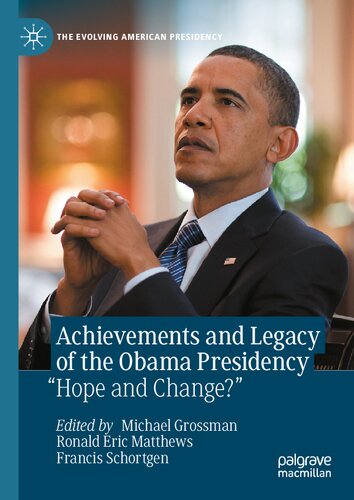موضوعات
آموزش و پرورش
ادبیات و زبان
پزشکی، دندانپزشکی و داروسازی
تاریخ و جغرافیا
داستان و رمان
دیگر
دین و فلسفه
روانشناسی
ریاضیات و آمار
سلامتی، تناسب اندام و رژیم غذایی
شیمی و پلیمر
علوم اجتماعی و حقوق
علوم زیستی و بیوتکنولوژی
فیزیک و نجوم
کامپیوتر و اینترنت
کتابهای کودکان و داستان
کسب و کار و اقتصاد
کشاورزی و دامپزشکی و غذا
معماری
مهندسی و فناوری
هنر و تئاتر
محصولات
Achievements and Legacy of the Obama Presidency: “Hope and Change?” - Original PDF
نویسندگان: خلاصه: Campaigning on the simple mantra of HOPE, Obama’s mindset was that his legacy would not be one of race or ethnicity but one of positive change and unity across the political divide. He arrived in Washington, D.C. riding a wave of optimism as the American polity had grown tired and weary of the partisan politics and was looking for a “savior of sorts” who would restore their belief in the American dream and in equality and justice for all. But as Chuck Todd (2014: 471) notes, “hope is one thing, change another.” Obama would spend the next eight years fighting the partisanship and political dysfunction that he was elected to trans- form, including at times a debilitated Democratic controlled Congress and Republicans who sat out to stop every attempt of the president to bring about change. Despite all this apparent chaos, confusion and partisanship, Obama went to work to fulfill many of his campaign promises. In so doing, he would work with anyone who wanted to change the status quo. Obama would advocate for revising the social safety net programs and appear to be siding with Republicans while angering Democrats. At other times, he would side with Democrats for healthcare reform, gun control and amnesty for illegal immigrants to the disgust of his Republican counter- parts. When necessary, he would work around Congress by signing 276 executive orders and issuing another 1186 presidential proclamations. He gave us the Affordable Care Act, the stimulus, the Dodd-Frank Wall Street Reform, an executive action for Dreamers, the repeal of “Don’t Ask, Don’t Tell,” a nuclear deal with Iran, diplomatic relations with Cuba, a climate deal in Paris, a New START treaty, a reform of student-loan programs, and two liberal Supreme Court appointments (Frank 2019). As his second term came to a close, Obama would leave office with an impressive list of accomplishments but an approval rating 10 points lower than when he took office.1 When he left the Oval Office, the country had endured twenty-four straight years of polarizing presidents, all three of whom were elected, in part, to help end some of the acrimony (Todd 1 President Barack Obama would leave office with an approval rating of 57% according to a survey from the polling firm Gallup taken from January 9 to 15, 2017. Obama’s exiting approval rating is 23% points higher than those of former President George W. Bush but nine points lower than those of President Bill Clinton. 1 INTRODUCTION 3 2014: 490). But the divisiveness that had paralyzed so many presidents in their quest to fortify their legacy was waiting in the wings. Presidential legacies are often cemented by whom the electorate selects to take the place of the incumbent. Since the Civil War, only two presi- dents, Ulysses S. Grant and Ronald Reagan, have served two full terms, then given way to another member of their own party, winning a veri- table third term (Todd 2014: 481). Not so for President Obama. Despite having an “anointed successor” in Hillary Clinton and a seasoned Vice President in Joe Biden, Obama’s plan for a systematic overhaul of the bureaucracy and hope for an end to persistent inside-the-Beltway grid- lock would come to an abrupt halt. The plan to galvanize his legacy through the election of Hillary Clinton was stopped dead in its tracks when Republican maverick Donald J. Trump was elected the 45th Pres- ident of the United States in an election result that even the staunchest Republicans called shocking.آیا کتاب مورد نظر هنوز بر روی سایت قرار نگرفته است؟ جای نگرانی نیست! کافی است بر روی گزینه سفارش کتاب کلیک کرده و درخواست خود را ثبت کنید. در کمتر از چند ساعت کتاب شما را آماده خواهیم کرد.
